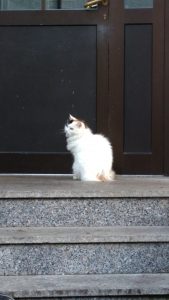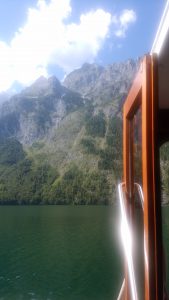20年ぶりのオーストリア/Coming back to Austria after 20 years
プライベートでは20年ぶりのドイツ⇒オーストリアへ入国
80年代後半から90年代まで、途中で何度か間が空きながらもドイツで暮らしていました(主にベルリン、フランクフルト・アム・マイン)。仕事は大変でしたが、当地の生ビール(今でもPils vom Fass!生ちょうだい!と注文したくなります)や、フランクフルト郊外の温泉療養地バッド・ゾーデン(Bad Soden)での暮らしはいまだに懐かしく思い出します。その後、仕事では何度かドイツに出張したことはあるのですが、プライベートでは実に20年以上ドイツに戻ったことはありませんでした。2016年になって久しぶりにドイツはミュンヘン経由で、オーストリアに入ってみようかという話になりました。
2016年9月初頭の1週間だけの夏休み。時間が限られているため、昔暮らしたフランクフルト近辺には行かずに、南のミュンヘンから入国し車でザルツカンマーグート(Salzkammergut)の終点ハルシュタット(Hallstatt)に向かうことに。メインの滞在先はハルシュタット。最後にミュンヘンでも2泊してフランスの友人と郊外で会うことを約束。
Visiting Germany and Austria privately for the first time after 20years
I had been living in Germany between late 80s and 90s intermittently mainly in Berlin and Frankfurt a.M.). Although it was tough job, I still miss Draft beer (You have to order “Pils von Fass!”) and the life in Bad Soden (hot spring resort in suburban area of Frankfurt). After that I visited Germany for business a couple of time but I had not visited there as private trip for more than 20 years. I decided to visit there and Austria in 2016 with my wife again. Travel schedule is only one week in beginning of September. So that we gave up the visit to Frankfurt area. We plan to enter Germany at Munich and then go to Hallstatt in Salzkammergut (Austria) by car. And before leaving Munich for Japan, we also planned to see my French friends in Munich to drink beer together.
(English text continues to the latter half of the page)
まずはドイツに入国
定刻通り昼過ぎにミュンヘン国際空港に到着。入国審査を終えてまずやった仕事は・・・。

これがドイツ入国後の最初の仕事!まずは到着ゲートの脇にあったパブで本場のビールを注文。これはヴァイツェン(Weizen)のHefeの500CCグラス。一気に飲み干しました。ヴァイツェンはバイエルン州の代表的なビールの種類で、ドイツ人は夏の間このビールでビタミンを摂取しているのではないかと感じるほどです。残念だったのはクリスタルがたまたま無かったこと。ヴァイツェンにはクリスタルとヘフェの2種類があり、どういうわけだか日本にはヘフェしか輸入されていないんです。
空港でレンタカーを借りて、この日はミュンヘンに1泊。翌朝、車でオーストリア方面へ南下を開始しました。
山頂のチャペル、ヴェンデルシュタイン(Wendelstein)
まず向かったのはドイツのほぼ南の端っこ、チロリアンアルプスの北端に位置するヴェンデルシュタイン(Wendelstein)山(1,838m)。山頂に建てられた教会堂はドイツ国内で最高度の教会として有名。ドイツ人のリゾートとしては知られていますが、どういうわけだが日本のガイドブックには一切出ていない穴場の観光地でもあります。

山頂にはこのアプト式鉄道で麓から登っていきます。車両の前部に貼ってあるように、この年が鉄道竣工100周年だったようです。

中腹からのショット。この日は晴れ上がった日曜日。同じ車両の中に日本人と言うか、アジア人は一人もいません。やはり外国人旅行者にとってはかなりマイナーなところですね。

実はこの教会の中を観たかったのですが、ちょうど改築工事中で中に入れなかったことは残念。到着したのが日曜の午前中だったのでミサが行われており、神父も信者の方々もチャペルの外で集まっていました。皆日曜ごとに電車かロープウエイに乗ってここまで集まってくるわけか。恐らくここで結婚式をするカップルもいるんでしょうね。とてもフォトジェニックな場所だと思うんですが、最後までアジア系の観光客には出会いませんでした。

実はこの山頂近くに鍾乳洞もあります。上の写真で鉄道のトンネルが見えますが、そのすぐ上あたり。自分は世界中どこに行っても“穴”があれば入ってみるという“穴マニア”です。もちろん入ってきました。
入り口を入ったばかりのところで1匹の蝙蝠が飛び回っていました。歓迎しているのか、威嚇しているのか。

これは写真がブレてしまいました!鍾乳洞の一番奥に設えてあった礼拝堂の写真です。
ザルツブルク郊外のアイスリーゼンヴェルトへ
ヴェンデルシュタインでランチを終えてから向かったのが、ザルツブルク郊外のアイスリーゼンヴェルト(Iceriesenwelt)。地名を直訳すると「巨大な氷の世界」。最近になって観光地としてリノベーションされたようですが、オーストリアでは20世紀に入って開発された場所。夏季のみ中に入ることができます。ただこの頃はまだ旅のBlogを意識してなかったため、ほとんど写真が残っていません!せめて施設の公式HP(http://www.eisriesenwelt.at/en/)で雰囲気を楽しんでください。
ツアーの途中で動画を撮ってみましたが、明度の調節がうまくいっていません。情けない・・・。
ハルシュタットに到着、変化に愕然!

日曜夕方にハルシュタットに到着。実に20年以上ご無沙汰でした。ハルシュタットは映画『Sound of Music』で有名になったザルツカンマーグートのほぼ終着点。チロリアンアルプスの山あいに宝石のように広がるハルシュタット湖と峻険な山の斜面に挟まれた細長い土地に開けた小さな町(村と言った方がいいレベル)。少なくとも数千年前から人間が住み着いていたことが確認されており、欧州の青銅器時代終期から鉄器時代前半の一時期(BC1,200~BC500頃)を「ハルシュタット紀」と呼んだりもしています。こんなに峻険な斜面の土地になぜ人が住んでいたかというと、そこに良質の塩山があったため。人間の生活に塩は欠かせず、特に冬の保存食が必須となるヨーロッパの生活では「塩」は生存に関わる物資でした。ザルツブルクを始め、ドイツ、オーストリアには「ザルツ」のつく地名が数多くありますが、「ザルツ」とは「塩」のこと。ハプスブルク家が領内に多くの塩山を持ち、塩の専売制を確立したことで繁栄の礎を築いたことはよく知られたことです。ハルシュタットの塩山も古来より知られた膨大な埋蔵量を誇る塩山で、(今回は行かなかったんですが)現在ではその一部が観光客に公開されて人気スポットになっています。坑道の中には1734年に発見された先史時代の塩山鉱夫の塩漬け遺体の復元展示もあります。通称「ザルツマン(英語でソルトマン)」と呼ばれる彼は何らかの原因で坑道の中で落命したまま天然の塩漬けになり、遺体が腐らないまま18世紀に発見されたもの。当時の衣装や鉱山の道具もそのまま残され、現在ならば「アイスマン(1991年にオーストリア-イタリー国境のエッツ氷河で発見された約5,300年前の男性の氷漬けの遺体)」に匹敵する大発見のはずですが、その後ザルツマンの遺骸は行方不明になってしまったそうです。彼が身に着けていた服装と道具の一部だけが現地の博物館で展示されています。
ところで自分がこのハルシュタットを初めて訪れたのは80年代後半、まだ20代前半の若造の頃、たまたまドイツの銀行で研修を受けていた時の休暇に車でザルツカンマーグートを回っていた時にふと見つけた場所でした。当時はまだ日本のガイドブックにも掲載がなく、村の居酒屋で飲んでいてもほかに日本人を見かけたこともありませんでした。水底まで透き通った湖の畔に開けた村は観光主義とは無縁の静けさ、おそらく明け方に対岸でバイオリンを弾いたら、朝もやの湖面を美しい調べがこちらにまで響いてくるような光景を想像するようなそんな静かで、なおかつ歴史的価値を持った村でした。それから90年代前半まで度々訪れましたが、徐々に日本の観光ガイドにも登場し始めたとは言え、あくまで山あいの静かな村と言う風情は変わりませんでした。

湖畔から対岸の街を臨んだところ。
今回はもう20年以上訪ねていないこの想い出の地を再訪したわけですが、結論を正直に言ってしまうとあまりの変容ぶりに愕然としました。風景自体は変わっていないものの、底まで澄み切っていた湖がうっすら汚れているように見えた(いや、それでもきれいな水には違いないんですが)ことに加えて、小さな街中を大人数の中国人が行き交っています!かつては見られなかった土産物店も大繁盛。たとえて言えば、かつて堀辰雄が愛した信濃追分と現在の軽井沢のような違いに驚きました。宿で聞いたところでは、村はずれに出来た大きなホテルを中国資本が買収したとのことで、大型ツアーが何組も来ているようです。ただ一般的に“中国人観光客”と言って日本人が連想するような行儀の悪いイメージとは違って、それぞれ小グループで優雅に街を歩いていてそれほど現地でも迷惑そうな印象は受けませんでした。おそらく中国の中でも欧州に旅慣れた富裕層を対象にしているのかもしれません。ただやはり想い出の地が変わってしまったことには変わりがなく、少し落胆してしまったことは否めません。


たとえ街の雰囲気が変わっても猫は相変わらず優雅な佇まいを崩しません。

ここは比較的新しくできたハルシュタット郊外の観光施設『Five Fingers』。名前の由来は崖から突き出した5本の指状の欄干。金網の上に立つと足の下は一気に数百mの断崖。一種の肝試しスポットの趣も。

欄干の端からハルシュタットを見下ろしてみました。

実は同じ山の中に二つの鍾乳洞があります。上の写真の中腹当り。もちろん二つとも入ってきました。
再びミュンヘンへ―フランスの友人と1年ぶりの再会
ハルシュタットを満喫した後は再びミュンヘンに向けて出発。その途中で国境近くの(ドイツ側)のケーニッヒスゼー(Koenigssee)で待ち合わせ。相手は1年前まで日本で合気道の稽古を一緒にしていたフランス人のカップル。今回自分がドイツに行くことになり、ミュンヘンで一緒にビールを飲もうということで、わざわざシャンパーニュ地方のランスから車で出てきてもらいました。たまたま向うも別の旅程を合わせて来てくれたけど、考えてみればシャンパーニュからミュンヘンまで500Km以上あるんですね、日本人にとっては同じヨーロッパの中という意識があるんですが、はるばる車を運転してやってきてくれた彼らに感謝!

久しぶりに再会したら、何と赤ちゃんができてました!すでに3か月ということで彼女はビールは無しです。ケーニッヒスゼーの畔のビール食堂でランチ。
ケーニッヒスゼーはドイツのほぼオーストリアの国境沿いで、いわばドイツの“飛び地”にあたるところ。ハルシュタットのようにアルプスの山並みに囲まれた細長い湖で、湖を行き来するボートは湖畔の静寂を守るため電動モーターで運行されています。この地が特に有名なのは、ヒトラーの山荘が目の前の頂にあること。この山荘は連合軍に破壊されてしまいましたが、秘書のマルティン・ボルマンがヒトラーの50歳の誕生日に突貫工事でプレゼントしたというティーハウスは健在で、現在でも訪れてお茶をすることができます。

湖を進むボートの中からヴァッツマン山系を撮りました。音もなく湖面を滑るボートは、この山系の岸壁の前に止まり、船頭さんがトランペットを吹いて岸壁からの見事なエコーを聞かせてくれます。
彼らとはその夜ミュンヘンのパウラナー(Paulanar)という老舗のビール醸造所が運営するビール酒場で思う存分ビールをいただきました。今回は彼らに無理を言ってしまいましたが、やはり世界に友人を持つことはいいことですね。実感しました。
ミュンヘン最後の日に撮った動画です。市内の公園を流れる川でサーフィンをする人々。最近は日本のテレビにも出て有名になったところですが、水量の多い川でたまたま川底に突き出た形状の岩があるため、こうした流れになっているようです。
Visiting Germany and Austria privately for the first time after 20years
I had been living in Germany between late 80s and 90s intermittently mainly in Berlin and Frankfurt a.M.). Although it was tough job, I still miss Draft beer (You have to order “Pils von Fass!”) and the life in Bad Soden (hot spring resort in suburban area of Frankfurt). After that I visited Germany for business a couple of time but I had not visited there as private trip for more than 20 years. I decided to visit there and Austria in 2016 with my wife again. Travel schedule is only one week in beginning of September. So that we gave up the visit to Frankfurt area. We plan to enter Germany at Munich and then go to Hallstatt in Salzkammergut (Austria) by car. And before leaving Munich for Japan, we also planned to see my French friends in Munich to drink beer together.
Entry to Germany
We arrived in Munich International Airport as scheduled. After Pass control I did my first job in Germany.

This is my first job in Germany! I drank up genuine German beer at besides arrival gate. This is 500cc glass of Weizen Hefe. Weizen is typical Bavarian beer. It seemed like Germans take Vitamin during summertime with this. Only one shame was there was just accidentally no Weizen Crystal. There are Hefe and Crystal in Weizen and only Hefe is imported to Japan.
We rent a car in the Airport and stayed a night in Munich. Next morning we started going south heading toward Austria by car.
Wendelstein: Chapel on the Summit
Our first destination is Mt. Wendelstein (1,838m) which is located on the south edge of Germany and northern edge of Tirolian Alps. The chapel on its summit is known as the church at highest elevation in Germany. Although it is very familiar resort for German local people, nothing about it is written in Japanese guidebooks.

This abt system train brings us to the summit from the mountain foot. As it is shown on train front, that year was 100th year celebration of the railroad.

This is the shot from the middle of the mountain. It was sunny Sunday. I didn’t see any Japanese tourists nor from Asia. It should be a minor resort for foreign tourists.

Actually I had wanted to look into the chapel but it was accidentally under construction. We arrived around morning time of Sunday and priests and people were gathering outside of the chapel. They may climb up here every Sunday morning by the train or ropeway. Many couples might hold wedding ceremony here and it looked so photogenic but I didn’t see any tourists from Asia until the end.

There is a limestone cave in summit area. You can see tunnel at the photo above. The cave is just above the tunnel. To be honest I am “cave mania” who try any caves in the world. So I entered to this cave as well, no doubt.
I saw the bat is flying around the entrance. Is he welcoming or threatening?

Sorry! This is a poor shot. This is a chapel deep inside of the cave.
Iceriesenwelt in suburban Salzburg
After the lunch in Wendelstein we dropped on Iceriesenwelt in suburban Salzburg. Iceriesenwelt means “Giant world of Ice”. It is the ice cave which was discovered in the beginning of 20th century and the cave is open for public during summer season. I have to apologize. I didn’t take photos of the place as I have not minded Blog at that time yet. Please have an atmosphere of Ice world from official site(http://www.eisriesenwelt.at/en/)
I took the movie during the tour but it looks so shabby and dark. Sorry!
Arrived in Hallstatt which shocked me of transfiguration!

We arrived in Hallstatt in Sunday evening finally for the first time in more than 20 years. Hallstatt is positioned in Eastern end of Salzkammergut which has become famous from the film “Sound of Music”. It is a little village which is developed on the banks of Hallstatt lake and is surrounded by steep faces of Tirolian Alps. It is known that humankind started living in this area many thousand years ago and a certain period from late Bronze age to early Iron age (BC1,200-BC500) is called “Hallstatt age”. What has brought them to base in such a small inconvenient place? The answer is “Salt”. The mountain behind Hallstatt is superior qualified Rock salt mine. People need salt to live and especially for European people who need preserved food in winter time for survival. In Austria there are many places which has “Salz” in their names like Salzburg. Salz means salt. Habsburg dynasty established its base of prosperity by introducing monopoly system of salt. In the mine you can also find restore exhibition of “the Salzman”. He is considered to be an ancient mine worker of several thousand years ago who died in the mine with accident or deceases. His body was preserved in salt with his clothes and mine tools and he was found again in 1734. It should be the great discovery as well as “Iceman (the body of 5,300 years ago found at Oetz glacier in Austria in 1991)” but the body of “Salzman” was missing now and only his belongings are exhibited in the museum in Hallstatt.
20s. At that time I took traineeship program in a German bank and I drove around Salzkammergut and found the place just by happening. At that time no article of Hallstatt was found in Japanese guidebooks and I didn’t see any other Japanese tourists. The lake was so clean and beautiful that I could see the bottom of the water very clearly. And the village was so quiet that it never looked like other tourism places. If somebody plays Violin on the other side of the lake in the dawn, you would feel echoes of the sound slipping on the surface of the lake. This place was such a quiet and historically valuable village. After that I visited Hallstatt often until early 90s. Even Japanese guidebooks started introducing Hallstatt but it had stayed quiet and beautiful village in Tirolian Alps.

Facing another side of the lake.
I visited Hallstatt, the place of my memory, for the first time in 20 years. In conclusion I was truly shocked by its transfiguration. Landscapes are just the same but I felt the lake water has become unclear though it is still clear. What I was surprised most was a bunch of Chinese tourists everywhere on streets and I saw many souvenir shops which I had never seen before. I heard that Chinese capital had bought big hotel in the town and big tourist groups started visiting Hallstatt. However most of them behave not bad on the contrary of the image we have against Chinese tourists. Maybe they are wealthy and used to travel in Europe. But I can’t deny I was a bit disappointed with the change.


The town has changed but cats are keeping their elegant postures.

This is recently developed tourism facility called “Five Fingers”. The name derives from fingers figured handrails on the cliff. Under the handrails are cliff of many hundred meters. It can be used as a sought of the spot of testing courage.

The view from the handrails over Hallstatt.

There are 2 limestone caves in this mountain. About middle of the mountain surface of the photo above. Off course I visited both of them.
Munich Again-I saw my French friends again
After enjoying Hallstatt area for 4 days we went back to Germany again. I had promised to see my French friends at Koenigssee on German-Austria border. We had trained Aikido together in Tokyo until a year ago. I asked him to come to Germany and drink beer together. The distance between Reims, Champagne, and Munich is more than 500km. I really appreciated his efforts to come there.

Oh, they expected a baby! It was 3rd month and she quit drinking alcohol. We had lunch on the bank of Koenigssee lake.
Koenigssee is located on the border between Germany and Austria. It is an enclave of Germany. The lake is long and narrow surrounded by Watzmann mountain range. Boats on the lake are operated by electric motors to keep the silence of the area. This place is very famous with Hitler’s villa on the summit which was destroyed by allied forces. However the teahouse which was built by Martin Bormann, Hitler’s secretary, as a present of his 50’s birthday still remains and is open for visitors nowadays.

This is a shot toward Watzmann mountains from the boat. The captain of the boat stops it before the cliff and play trumpet to make guests listen to echoes.
At the night we had drank beer so much in Paulaner (local traditional beer brewer) diner in Munich. Sorry for the long way! But it was so nice to have friends abroad.
This is the movie I took in Munich. People enjoy surfing on the river flowing in the park which was recently introduced by Japanese TV as well. An underhanging rock on the bottom of the river makes this wave.
